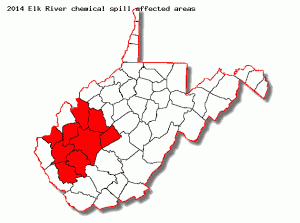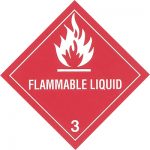The January 9th chemical spill in which some 7,500 gallons of the coal-cleaning chemical 4-methylcyclohexanemethanol (MCHM) leaked into the nearby Elk River is believed to be one of West Virginia’s worst ecological disasters of all time. It left nearly 300,000 residents in nine counties of the Charleston, West Virginia metropolitan area without access to clean water. While officials have since declared the water safe to consume, the effects of this disaster are still being felt throughout the state.
Last month, the West Virginia Department of Health and Human Resources (DHHR) released a medical report on the injuries and illnesses stemming from the January 9th chemical spill. The purpose of this report was to determine what type of impact MCHM had on residents’ health. Government officials contacted nearly 800 medical professionals in the the Charleston, West Virginia metropolitan area, asking them to provide data on injuries and illnesses related to the chemical spill.
According to the DHHR’s report, 63 of the 800 medical professionals responded to the request. Granted, this is a low response rate, but it provided some rather interesting information regarding the incident and its impact on public health. The report reveals that the most common symptom of exposure to the MCHM was itching. 32 residents in the Charleston, West Virginia metropolitan area complained to doctors and medical professions about itching. The second most common symptom of exposure was a skin rash, which was reported by 13 people in the area.
It’s important to note that data collected for the report was based strictly on the response from the 63 medical professionals. West Virginia government officials noted that hundreds of residents had initially reported adverse symptoms stemming from exposure to the MCHM. Other reported symptoms include coughing, eye irritation, vomiting, nausea and headaches. While hundreds of residents reported experiencing adverse symptoms related to MCHM exposure, there were no fatalities attributed to the Elk River chemical spill.
Officials say the DHHR’s report is consistent with earlier reports conducted by the CDC and West Virginia Poison Control Center.
“What we are seeing is consistent with the information that has been previously reported by the West Virginia Poison Center, the Center for Disease Control and Prevention’s (CDC) initial medical chart review from emergency departments and the population survey conducted by the Kanawha-Charleston Health Department,” said Letitia Tierney, State Health Officer and Commissioner for the Bureau for Public Health.







 Chemical spills or leaks can pose a direct threat to workers’ health, the environment, and nearby animals. This is why the Occupational Safety and Health Administration (OSHA) and the Environmental Protection Agency (EPA) have strict rules in place. For both the prevention and cleanup of workplace hazardous chemical leaks or spills.
Chemical spills or leaks can pose a direct threat to workers’ health, the environment, and nearby animals. This is why the Occupational Safety and Health Administration (OSHA) and the Environmental Protection Agency (EPA) have strict rules in place. For both the prevention and cleanup of workplace hazardous chemical leaks or spills. OSHA requires companies to properly label any hazardous chemical that it stores or uses in the workplace. Each type of chemical must have a clear and accurate label describing its contents. For instance, whether it is flammable, corrosive, oil or another chemical type in the list above. Color coding your
OSHA requires companies to properly label any hazardous chemical that it stores or uses in the workplace. Each type of chemical must have a clear and accurate label describing its contents. For instance, whether it is flammable, corrosive, oil or another chemical type in the list above. Color coding your  Have questions about which chemical spill containment or absorbent products to purchase? Contact Travis Zdrazil at
Have questions about which chemical spill containment or absorbent products to purchase? Contact Travis Zdrazil at